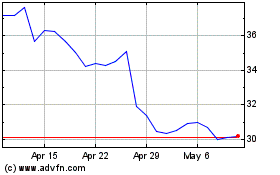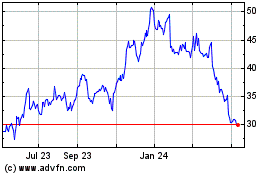Qualcomm Looks Beyond Smartphones With New Chip
January 03 2017 - 5:29PM
Dow Jones News
By Georgia Wells
LAS VEGAS -- Qualcomm Inc. views its latest smartphone chip as a
"connected device" chip, a bid to outdistance rivals such as Intel
Corp. in the burgeoning market for gadgets and equipment with
computing and communications capabilities built in.
The computer-chip maker based in San Diego unveiled its latest
premium chip, Snapdragon 835, on Tuesday at CES 2017, a
consumer-electronics show in Las Vegas.
Like previous Snapdragons, the new model includes upgraded
technology expected to improve the performance of coming
smartphones incrementally and drive consumers to upgrade their
handsets. But the chip also includes features designed to process
images and sound for augmented reality and virtual reality, and its
improved battery life and smaller size might suit it for small,
internet-connected devices.
The new chip's potential in devices other than smartphones is
important to Qualcomm, because Qualcomm's reliance on the phone
market leaves it exposed to the slowing growth of smartphone
shipments. Qualcomm is one of the largest suppliers of chips that
enable phones to communicate with cell networks.
Qualcomm has moved in recent years to diversify its business to
markets similar to those that already use its chips, such as
connected devices.
Intel, whose chips provide computing power in most computers,
also unveiled Tuesday its latest processors designed for computers,
virtual reality and videogaming. The processor boosts performance
of videogaming laptops by as much as 20%, according to Intel, and
makes it easier to stream 4K video without additional, specialized
hardware. The processor is a part of the 7th Gen Intel Core
processor family that Intel announced in August, code-named Kaby
Lake.
Qualcomm beat rivals to market with chips bearing transistors
that measure 10 nanometers, the smallest produced commercially by
any chip maker. Qualcomm unveiled in December a chip for servers
that, like the new Snapdragon, has 10-nanometer transistors. Intel
expects to bring to market its own chips with 10-nanometer features
this year.
The minuscule transistors on Qualcomm's new chip are smaller
than those of its previous model, the Snapdragon 820. The new chip
uses 25% less power than the previous model, according to Qualcomm.
The smaller transistors also make for a smaller chip: It is now a
bit smaller than a penny, while the previous model was about the
size of a penny.
Companies planning to use the new chip include augmented- and
virtual-reality developer Osterhout Design Group in San Francisco.
ODG said Tuesday that its latest smart glasses will use the
Snapdragon 835. A spokesman for Qualcomm also said a new
voice-assistant home appliance is expected to use the new chip.
Artificial- and virtual-reality headset makers aim to make their
gadgets smaller and more power-efficient, which might make the new
chips attractive in those devices.
The new Snapdragon also processes virtual-reality content in a
new way that allows the wearer to experience depth; now when the
user walks toward an object in virtual reality, the object gets
bigger.
For security, the new chip also will be able to process voice
and eye data so users can unlock devices through the sound of their
voices or images of their eyes.
Write to Georgia Wells at Georgia.Wells@wsj.com
(END) Dow Jones Newswires
January 03, 2017 17:14 ET (22:14 GMT)
Copyright (c) 2017 Dow Jones & Company, Inc.
Intel (NASDAQ:INTC)
Historical Stock Chart
From Mar 2024 to Apr 2024

Intel (NASDAQ:INTC)
Historical Stock Chart
From Apr 2023 to Apr 2024
